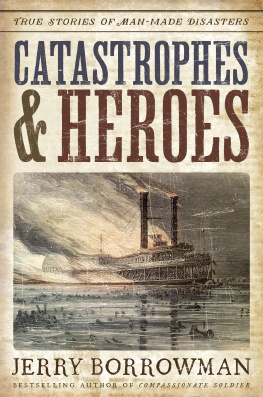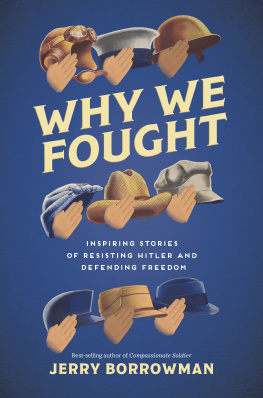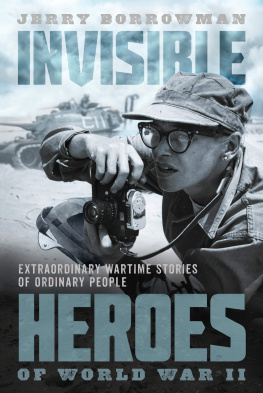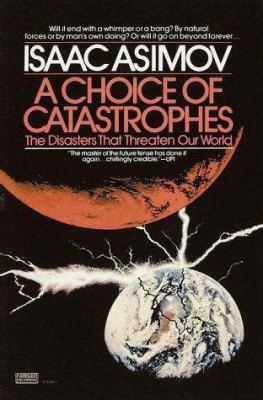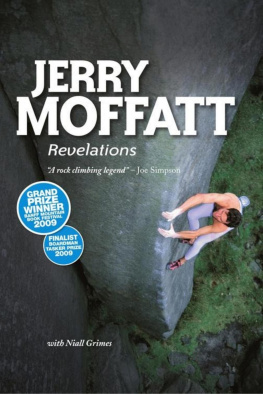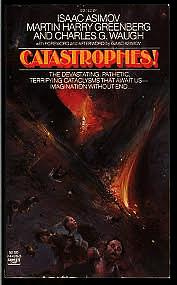Jerry Borrowman - Catastrophes and Heroes
Here you can read online Jerry Borrowman - Catastrophes and Heroes full text of the book (entire story) in english for free. Download pdf and epub, get meaning, cover and reviews about this ebook. year: 2020, publisher: Shadow Mountain Publishing, genre: Detective and thriller. Description of the work, (preface) as well as reviews are available. Best literature library LitArk.com created for fans of good reading and offers a wide selection of genres:
Romance novel
Science fiction
Adventure
Detective
Science
History
Home and family
Prose
Art
Politics
Computer
Non-fiction
Religion
Business
Children
Humor
Choose a favorite category and find really read worthwhile books. Enjoy immersion in the world of imagination, feel the emotions of the characters or learn something new for yourself, make an fascinating discovery.
- Book:Catastrophes and Heroes
- Author:
- Publisher:Shadow Mountain Publishing
- Genre:
- Year:2020
- Rating:5 / 5
- Favourites:Add to favourites
- Your mark:
- 100
- 1
- 2
- 3
- 4
- 5
Catastrophes and Heroes: summary, description and annotation
We offer to read an annotation, description, summary or preface (depends on what the author of the book "Catastrophes and Heroes" wrote himself). If you haven't found the necessary information about the book — write in the comments, we will try to find it.
Catastrophes and Heroes — read online for free the complete book (whole text) full work
Below is the text of the book, divided by pages. System saving the place of the last page read, allows you to conveniently read the book "Catastrophes and Heroes" online for free, without having to search again every time where you left off. Put a bookmark, and you can go to the page where you finished reading at any time.
Font size:
Interval:
Bookmark:


2020 Jerrold J. Borrowman
All rights reserved. No part of this book may be reproduced in any form or by any means without permission in writing from the publisher, Shadow Mountain, at permissions@
shadowmountain.com. The views expressed herein are the responsibility of the author and do not necessarily represent the position of Shadow Mountain.
Visit us at shadowmountain.com
Library of Congress Cataloging-in-Publication Data
(CIP data on file)
ISBN 978-1-62972-739-4
eISBN 978-1-62973-923-6 (eBook)
Printed in the United States of America
Lake Book Manufacturing, Inc., Melrose Park, IL
10 9 8 7 6 5 4 3 2 1
Cover illustration courtesy of Library of Congress
Author photo by Lamonte G Photography
Book design Shadow Mountain
Art direction by Richard Erickson
Design by Barry Hansen
Also by Jerry Borrowman
Beyond the Call of Duty
Compassionate Soldier
Invisible Heroes of World War II
Contents
Acknowledgments
Id like to express appreciation to my wife, Marcella Borrowman, for her insightful story edit and to my readers panel for the time they spent reviewing the text, correcting errors, and improving the storytelling. Thank you to Brian Ellis, Norman Jenson, Bill Gallagher, Sharron and Tom Sandquist, J. R. Jones, Kelissa Peterson, and Dennis Russell.
Introduction
We live in a world in which we are completely dependent on an almost invisible but highly engineered infrastructure that makes modern life possible. Technology enables us to flip a light switch that is always connected to a reliable source of electricity, turn a tap that brings fresh water, and drive on roads that effortlessly span chasms and bodies of water without a pause. But behind all these conveniences are massive dams and bridges funded by taxpayers. Privately maintained railroad tracks enable high-speed trains to move millions of railcars filled with food and other vital commodities. Power companies use a variety of fuels to create and distribute electricity. And all this is so well-designed that we hardly give it a thought, at least until something goes wrong. Then something does go wrongsevere weather, sabotage, poor design or workmanship, lack of maintenanceand a catastrophe strikes.
Following are eight stories of spectacular failures that caused great suffering and loss of life. Each story has five parts: (1) an overview of the disaster; (2) the fateful choices that led to the disaster; (3) the unintended consequences; (4) the heroic efforts involved in the disaster, including the first-responder heroes who risked their lives to save others, and then the professional, regulatory, or governmental heroes who fought for permanent change to avoid future catastrophes; then (5) the lessons learned by those responsible for either the disaster or its cleanup.
In each situation, a person in authority had a decision to maketo follow best practices or to take shortcuts. These disasters were preventable, but those who should have acted better failed to do so because of incompetence, greed, or malice.
After the failures, it fell to others to help rescue those who were injured and to then help the affected communities rebuild. Heroic efforts were made to save the victims and offer relief to the suffering. The rescuers stories are inspiring.
Finally, lessons were learned from each tragedy and steps were taken to prevent the mistakes from happening again. An important and redemptive part of each story is that from tragedy comes progress.
The stories are told in chronological order, starting in 1865 with the Mississippi steamboat Sultana and ending in 1963 with Italys Vajont Dam. I hope you enjoy learning about these stories as much as I have.
Chapter 1
1865: Prisoners on the Mississippi
The Human Cost of Tragedy
My experience on that terrible morning no pen can write, nor tongue can tell. I was thrown into the surging waves of that mighty river, into the jaws of death. Life depended on one grand effort, expert swimming, which I did successfully, and after swimming six or seven miles, according to statements given by citizens living on the banks of the river, landed on the Arkansas shore without any assistance whatever. There I found a confederate soldier who came to my relief, and took me to a house nearby, and gave me something to eat, and I felt something like myself again, thanks to the Great Ruler of the Universe. The said confederate soldier worked hard to save the lives of the drowning men and brought to shore in his little dugout about fifteen of them.
P. S. Atchley, a Union soldier from Trotters Store, Tennessee
Overview
Perhaps the greatest of all the suffering in the Civil War was that endured by the Union soldiers held as prisoners of war in Andersonville, Georgia. In Andersonville, some 32,000 men were crammed into a camp designed to support 10,000. Sanitation was appalling, with one small creek acting as both sewer and the source of drinking water. Dysentery and malaria were rampant. The soldiers were supposed to receive the same food ration as active-duty Confederate soldiers, but Georgias food supply was largely destroyed, so the prisoners received only meager rations. This included a daily portion of rancid grain or a cupful of cornmeal and perhaps a teaspoon or two of boiled peas or beans flavored with a few ounces of raw bacon or beef. This diet led to scurvy, malnutrition, and starvation. With no medical service to help them, 12,912 prisoners died while in captivity, an appalling 30 percent of those incarcerated. This photo of an Andersonville survivor shows the desperate condition in which the men struggled to stay alive.

A liberated prisoner of war from Andersonville.
The liberation of the camp at the end of the Civil War was an event that should have brought joy to the prisoners, but most were too weak to celebrate. Still, the promise of returning to their homes in the North offered hope. As soon as they were healthy enough to travel, a group of 2,000 liberated prisoners were transferred to Camp Fisk, near the Mississippi town of Vicksburg. Their official status was paroled until they went north to be mustered out of the Union army. Until then, they remained under guard and subject to the orders of their superior officers. It was at Vicksburg that they would transfer to steamboats headed upstream on the Mississippi River. Then they would travel on to their homes in Ohio, Michigan, Indiana, Kentucky, and Virginia.
But unknown to these paroled prisoners, even after all that they had endured, a new danger awaited them, a danger that was preventable except for the greed and avarice of two corrupt individuals.
The Steamship Sultana
In 1810, there were just twenty steamboats on the Mississippi River and its tributaries. By 1830, there were more than 1,200, and the number continued to grow until the outbreak of the Civil War. Through an intricate web of rivers and canals, it was possible to ship goods by river faster and at far less expense than by land-based transportation.
The inland steamboats of the era were engineering marvels. They opened nearly two million square miles of land to settlement and trade that today would include rivers in thirty-two states. The secret to their success was in the design of their flat-bottomed hulls, which drew just five to seven feet of water while supporting thousands of tons of superstructure, cargo, and passengers. A typical mid-century steamboat could easily transport 250 passengers and 10,000 bales of cotton, large quantities of livestock, and other cargo.
Font size:
Interval:
Bookmark:
Similar books «Catastrophes and Heroes»
Look at similar books to Catastrophes and Heroes. We have selected literature similar in name and meaning in the hope of providing readers with more options to find new, interesting, not yet read works.
Discussion, reviews of the book Catastrophes and Heroes and just readers' own opinions. Leave your comments, write what you think about the work, its meaning or the main characters. Specify what exactly you liked and what you didn't like, and why you think so.

